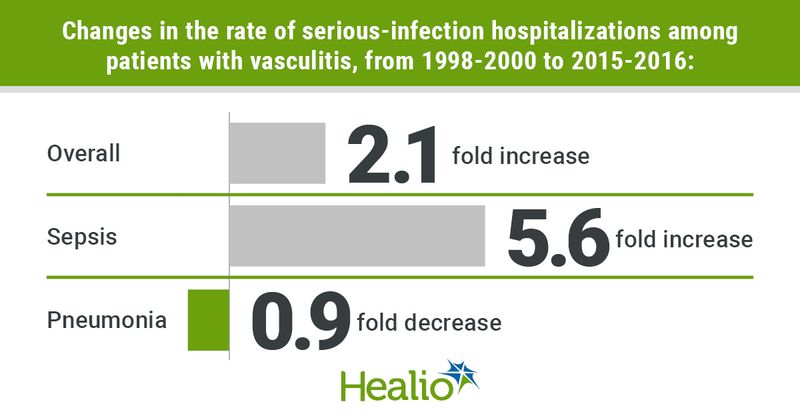Serious infection-related hospitalization rates nearly doubled in vasculitis
The rate of hospitalizations due to serious infection in patients with vasculitis nearly doubled over a 19-year period, according to data published in Arthritis Care & Research.
“Vasculitis is an autoimmune disease with significant morbidity and mortality,” Jasvinder A. Singh, MBBS, MPH, of the University of Alabama at Birmingham, told Healio Rheumatology. “Most published studies of hospitalized infections in vasculitis were limited to [antineutrophil cytoplasmic antibody]-associated vasculitis only. Additionally, these studies consisted of very small sample sizes, were limited to few centers only and did not assess associated healthcare utilization. Some studies were almost 1 decade old. Therefore, contemporary epidemiological studies of hospitalized infections in vasculitis are needed.”

To examine the epidemiology, time trends and outcomes of serious infections, as well as the types of infection, among patients with vasculitis in the United States, Singh and John D. Cleveland, MS, also of the University of Alabama at Birmingham, analyzed data from the U.S. National inpatient sample (NIS). According to the researchers, the NIS is a de-identified national all-payer inpatient health care database that represents a 20% stratified sample of discharges across the country.
Focusing on the 1998-2016 NIS, Singh and Cleveland identified patients with vasculitis who had been hospitalized with a primary diagnosis of pneumonia, sepsis or bacteremia, urinary tract infection, skin and soft tissue infections, or opportunistic infections. They then used adjusted logistic regression to examine the predictors of hospital stays lasting longer than 3 days, as well as total hospital charges greater than the median, discharges to a nonhome setting, and inhospital mortality.

According to the researchers, there were 111,345 serious infections among patients with vasculitis, accounting for 14% of all vasculitis hospitalizations during the analyzed time period. Overall hospitalization rates due to serious infection, per 100,000 NIS claims, among patients with vasculitis rose from 12.14 in 19982000 to 25.15 in 20152016, representing a 2.1-fold increase. Regarding specific infections, rates during this period increased from 0.78 to 0.83 for opportunistic infections, 1.38 to 2.52 for skin and soft tissue infections, 0.35 to 1.48 for urinary tract infections, and 2.53 to 14.1 — a 5.6-fold increase — for sepsis.
Meanwhile, rates of pneumonia decreased from 7.1 to 6.23 during this time. Pneumonia was the most common serious infection during the 1998 to 2000 period, with 58% of cases, but in 2015 to 2016 was supplanted by sepsis at 56%.
Sepsis, older age, a Deyo-Charlson index of 2 or greater, urban hospital location, and medium-to-large hospital bed count were associated with higher health care use and inhospital mortality. Locations in the Northeast region, as well as Medicare and Medicaid payer type, were also associated with higher health care use.
“A better knowledge of time-trends related to various types of serious infection hospitalization and their outcomes over time in people with vasculitis can help recognize high-risk groups and more careful planning during hospital care and post-hospital discharge,” Singh said. “Our study also provides the data on important patient, comorbidity and systems-level factors associated with healthcare utilization and mortality, that can inform the development of effective interventions that can improve these outcomes in people with vasculitis.”
